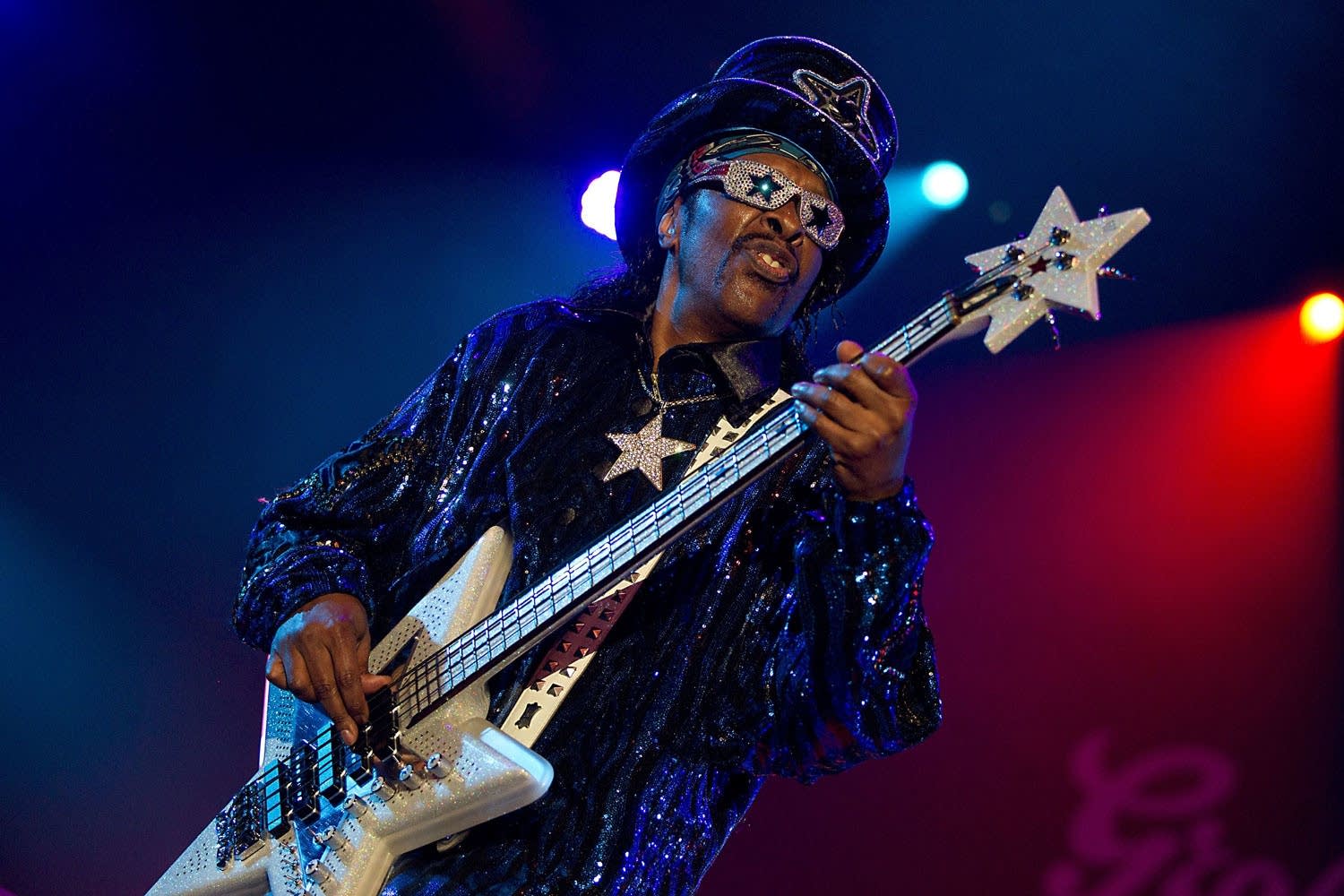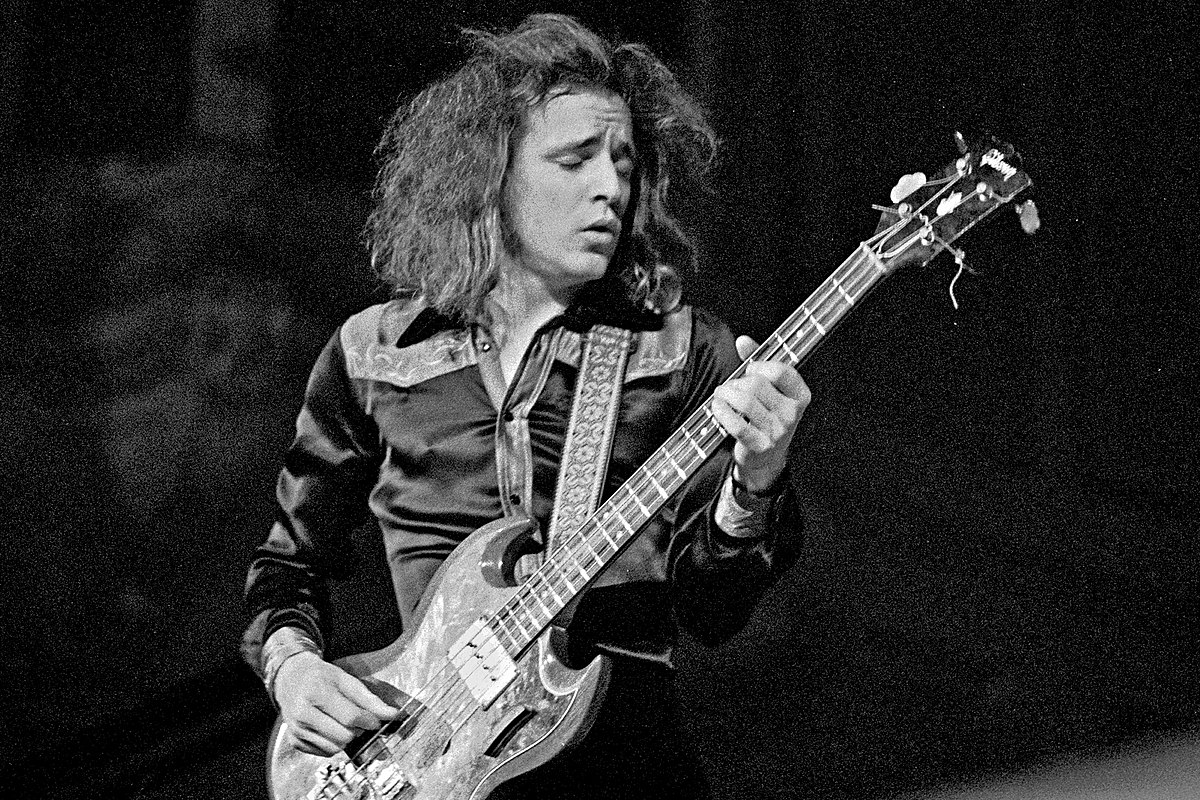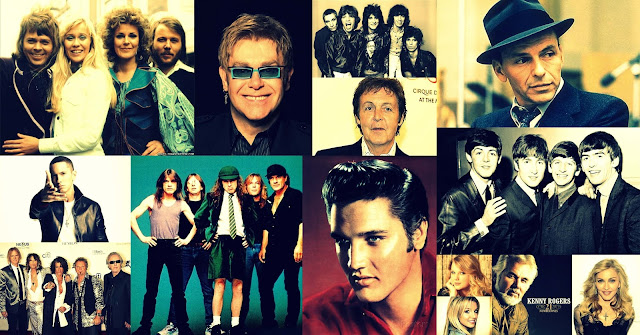25 Greatest Bass Players Of All Time
Here´s our definitive ranking of the 25 greatest bass players of all time. Texts taken by Music Radar, Notreble and Bassplayer.
25. John Deacon
24. Gene Simmons

What makes a bassist great? Simmons may not be the most technically gifted player on this list, but few here could beat him when it comes to the live arena and performance.
23. Bill Wyman

While the quote “It’s Only Rock and Roll But I Like It” has become a bit trite, there’s no denying the fact that it’s true. It requires a certain amount of raw talent, part-driven playing, and soulful swagger to play in one of the greatest rock and roll bands of all time. As an integral member of the Rolling Stones and the bass player on the hits we all love, Bill Wyman is a bass player to know.
22. Victor Wooten

Five-time Grammy winner Victor Wooten is a monster player who regularly takes the bass guitar on voyages of discovery as far away as can be from its traditional position in pop music.
21. Chuck Rainey

Rainey credits the 16th-note pulse of New York City drummers as the ingredient that set him apart from his peers in other cities’ classic rhythm sections. That percussion perk led the Ohio native to forge one of the cornerstone R&B styles, making an indelible mark with King Curtis, Aretha Franklin (“Rock Steady”), and many others. His early-’70s move to Los Angeles at the behest of Quincy Jones resulted in more seminal sides with Steely Dan (Kid Charlemange, Aja), Marvin Gaye, and the Jackson 5.
20. Lemmy Kilmister
The Rickenbacker bass, the black hat, the bottle of Jack Daniels, the mole, the legend. Few bassists have been the iconic face of rock in the way that Lemmy was. His playing with his speed-metal outfit Motör-head taught future generations of bass players that attitude is just as important as talent.
19. Boosty Collins

Bootsy has made bass history at least three times: as a teenage sideman with James Brown on classics like “Super Bad” and “Soul Power” (1961–’71); as co-creator of immortal Parliament–Funkadelic classics such as “Mothership Connection” and “Up for the Down Stroke” (1972–’80); and as ringleader of Bootsy’s Rubber Band, whose songs like “Stretchin’ Out (In a Rubber Band)” catapulted Bootsy—plus his Space Bass, vocal stylings, and Hendrix-inspired effects—to Saturday-morning-cartoon superhero status.
18. Carol Kaye
17. Peter Hook

Listen to classics like “Love Will Tear Us Apart” and “Ceremony” and marvel at how catchy and clear the bass lines are. It’s no surprise, then, that Hooky’s distinctive pick work with Joy Division and New Order, most famously on Yamaha BB1200S 4-strings and Shergold Marathon 6-strings, has had such a huge impact on post-punk and new-wave bass.
16. Chris Squire
When Squire first hit the FM airwaves with Yes, listeners weren’t even sure they were hearing bass. His zingy, aggressive riffs under songs such as “Roundabout” (1971), played on his Rickenbacker RM1999, made for a completely new sound—especially since he used both a pick and roundwounds. Squire’s machinelike precision, too, was a key part of the band’s vibe. “He was thinking outside the box,” says Yes guitarist Steve Howe. “It was like he jumped over the fence and saw it from the other side.”
15. Geezer Butler

Black Sabbath literally invented heavy metal in 1970, and Geezer Butler’s adventurous, unbound playing style remains the perfect foil to Tony Iommi’s monolithic guitar riffs. When they detuned to C# on 1971’s Master of Reality, they singlehandedly forged the template of the doom/stoner metal subgenre. Career highlights include Black Sabbath, Paranoid, and Heaven and Hell.
14. Flea
Flea’s aggressive, slap-heavy style with the Red Hot Chili Peppers lit up the mid-’80s L.A. scene, exemplified by their cover of Stevie Wonder’s “Higher Ground” (1989). By ’91, Flea had emerged with a refined style, largely trading in his slapping for muscular melodic statements, such as the back-and-forth ostinato on the hit “Give It Away.” Through the ’90s and beyond, Flea has remained one of the most visible and admired representatives of rock bass.
13. Cliff Burton

In only four years with Metallica, Cliff Burton recorded Kill ’Em All, Ride the Lightning, and Master of Puppets, and changed the world of metal bass forever. Known for his lightning-fast fingers, articulate soloing, and “lead bass” role, Burton achieved legend status before he died in a band bus crash in 1986.
12. Charles Mingus

The badass of jazz bass, Charles Mingus (1922–1979) worked with everyone from Duke Ellington to Langston Hughes. His in-your-face style was informed by bebop, Ellingtonian swing, and the blues of the church. Mingus’ early career focused on the swing and bebop scenes of the ’40s and ’50s. In 1956 he released his first noteworthy album, Pithecanthropus Erectus, which was followed by a string of groundbreaking recordings: The Clown, Mingus Ah Um, and Blues and Roots. In 1963, Mingus produced the large-ensemble album The Black Saint and the Sinner Lady and one of his best small-group efforts, Mingus, Mingus, Mingus, Mingus, Mingus. As a prolific composer, Mingus stood out with bass-friendly tunes like “Boogie Stop Shuffle,” “Haitian Fight Song,” and “Better Get It In Your Soul.” His style of playing was bold, exciting, and always grooving. Mingus had an uncanny knack for playing complicated harmonies, laced with blues. His willingness to explore all elements of bass playing—from free jazz to bop to down-home gospel blues—secures Mingus’ place in bass history.
11. Ray Brown

Impeccable technique, gorgeous sound, and driving swing define Ray Brown’s contribution to jazz. Brown (1926–2002) was present from the inception of bebop in the ’40s, playing alongside Charlie Parker, Dizzy Gillespie, and Bud Powell, and was a founder of the Modern Jazz Quartet. The traveling show Jazz at the Philharmonic brought him in contact with Oscar Peterson in the early ’50s, and he played in the Oscar Peterson Trio from ’51–’66. The Ray Brown Bass Method, first published in 1963, influenced a generation of jazz players. In the ’70s, he worked with his group the L.A. Four, and from the mid ’80s onward with the Ray Brown Trio. More than any other bassist, Brown outlined his unmistakable style with flawless time and intonation, combined with an affinity for blues and bebop, setting a high standard for straightahead jazz playing. He maintained a rigorous performing, recording, and touring schedule throughout his career, and appears on hundreds of albums. He cited Jimmie Blanton, Walter Page, Israel Crosby, and Oscar Pettiford as early influences.
10. Larry Graham
The story goes that as a teenager gigging with his mother, Larry Graham played organ pedals and guitar alongside a drummer. When the organ broke, he switched to bass until the organ could be fixed—and then the drummer left the band. “That’s when I started thumping with my thumb,” he said, years later. “It was the only way I could get that rhythmic sound.” That rhythmic sound changed the world, inspiring millions of would-be (and wannabe) bass heroes. Nearly half a century after Graham and his Jazz Bass invigorated Sly & the Family Stone standards like “Family Affair,” “Everyday People,” and “Thank You (Falletinme Be Mice Elf Agin)”—followed by stone-cold Graham Central Station classics like “Release Yourself,” “Can You Handle It,” and “Hair”—ageless, dapper Graham is still the baddest thumb-slinger around. As Victor Wooten says, “He is to funk bass what the Bible is to religion.”
9. James Jamerson

The most important and influential bass guitarist in the 66-year history of the Fender Precision he played, South Carolina-born, Detroit-raised James Jamerson wrote the bible on bass line construction and development, feel, syncopation, tone, touch, and phrasing, while raising the artistry of improvised bass playing in popular music to zenith levels. As Funk Brother #1 in Motown’s “Snake Pit,” Jamerson customized his approach to fit the style of each artist he cut with, including Stevie Wonder, Marvin Gaye, Diana Ross & the Supremes, Smokey Robinson, the Four Tops, the Temptations, and the Jackson 5—resulting in such masterworks as “Bernadette,” “I Was Made to Love Her,” “I’m Wondering,” and “What’s Going On.” That he tops our list adds to the irony of his dying in relative obscurity in 1983, at age 47, considering all of the accolades since then that have shined a light on his genius. It also speaks to a collective bass player understanding that the instrument’s function is still about support. Or as Stanley Clarke said in his March ’15 BP cover story, “Creating a great bass line is much harder to do than soloing. The true genius bassists are not the ones who play a million notes—it’s the ones whose bass lines are loved worldwide and remembered through history.”
8. Les Claypool

No ’90s alt-rocker reimagined the bass more than Claypool with Primus, and on a fretless 6-string, no less. On “Jerry Was a Race Car Driver” (1991), Les slaps, taps, and tritones his Carl Thompson bass to produce a frenetic whack-fest with a strong, slightly swinging 16th-note groove. Claypool got players asking, What on earth is he doing? And how can I do it, too?
7. Stanley Clarke
The first superstar of playing the bass, Philadelphia-born Clarke revolutionized and liberated the low end for a boundless wave of followers—including his SMV bandmates Marcus Miller and Victor Wooten—in myriad ways. This includes the artistic and economic feasibility of becoming a doubling, bandleading, composing, touring, and recording bass solo artist. More specifically, the Coltrane-inspired Clarke took the acoustic bass to new technical and musical heights, and with Trane and Hendrix in his ears, innovated by reaching upward on the bass guitar via tenor and piccolo versions. From Return To Forever, his seminal solo sides, and his funky pairings with George Duke, to the Rite Of Strings, his composing and conducting film scores, and producing, Clarke remains the Lord of the Low Frequencies.
6. Jaco Pastorious

After a year in which the music community suffered the loss of so many heroes, it’s sobering to realize just how drastically Jaco Pastorius changed our world in the short time he was here. In seven years, between 1975 and 1982, Jaco’s staggering contributions to discs by Pat Metheny, Joni Mitchell, and Weather Report radically upended our expectations of electric bass, and he further cemented his legend on records by Herbie Hancock, Albert Mangelsdorff, Michel Colombier, Al Di Meola, and others. In his own work, the charismatic Philadelphia native fused seemingly disparate elements—big bands, Motown, the Caribbean/Latin flavors of his South Florida upbringing, the influences of jazz heroes like Charles Mingus and Paul Chambers, the funk of James Brown’s bassists, Western classical, the innovations of contemporaries like Jerry Jemmott, and Paul McCartney’s melodicism—into a hip, soulful, signature cocktail with more than a twist of rock & roll attitude. Three decades after Jaco’s death at the hands of a South Florida bouncer, he’s still the gold standard for expressiveness and intonation on fretless bass, Jazz Bass back-pickup tone, and 16th-note stamina, but few can match his effortless blend of abundant technique and earthy groove.
5. Geddy Lee
Rarely do bassists achieve such universal acclaim. The 21 studio discs and 11 live albums bearing Geddy’s singular voice and signature bass tone have garnered seven Grammy nominations and an estimated 40 million sales since 1976. The most impressive numbers, however, are related to Geddy’s multi-tasking chops: His ability to trigger samples, play keys, step on bass pedals, and sing vocal parts in odd time signatures while nailing Rush’s complex yet catchy bass lines will always be mind-blowing. We’re sure his bass closet—packed with Rickenbackers, Jazz Basses, Wals, P-Basses, Steinbergers, Gibsons, Moog Taurus pedals, and even a fretless Ampeg AUSB-1—is pretty rad, too. And no stat could ever measure the depth and intensity of Rush’s worldwide fan family, which will most likely continue growing even though the trio has decided to stop touring.
4. Jack Bruce

When he was asked to play electric bass on a 1964 session, Jack Bruce immediately recognized the instrument’s potential. Classically trained at Scotland’s Royal Academy of Music, he had been playing upright in London jazz clubs—but also listening to James Jamerson and “striving to play melodies … while maintaining the bass’ function as an anchor.” He found the perfect vehicle for his vision of the instrument’s expanded role in Cream, where he could improvise freely within (and beyond) the chord progressions, creating lines that linked the blues-inflected guitar of Eric Clapton with the jazz-inspired drumming of Ginger Baker. His playing in the trio’s legendary live jams liberated the bass for generations of players who followed. After Cream, Jack continued to explore what he called “the blues element” in a long solo career and many collaborations— always pushing the limits, always seeking the profound self-expression that was his life’s goal.
3. Paul McCartney
While Jamerson and Jaco were changing the electric bass in their own way, Paul McCartney was doing it with extreme visibility, front-and-center with the Beatles. Early on, his bass lines were highly effective but fairly conventional, such as the energetic “I Saw Her Standing There” and “All My Loving” (1963). By 1967’s Sgt. Pepper’s Lonely Hearts Club Band, McCartney was creating unique ear-catching statements—from the loping swingoffbeats of “With a Little Help From My Friends” to the loopy, sliding lick on the choruses of “Lovely Rita.” Later Beatles bass masterpieces include the bouncy, sliding subhook on “Dear Prudence” (1968) and “She Came in Through the Bathroom Window” (’69), which goes from stately in the first verse to funky and syncopated in the second. And, of course, there’s “Come Together,” one of those songs where every lister knows that the bass is doing something special. A few of Macca’s most memorable machinations came after the Beatles, with Wings. Who could forget the ultra-catchy subhook under “Silly Love Songs” (1976)? It’s good enough not only to anchor the verses, but also choruses that would otherwise be about as melodically and lyrically powerful as boiled lint. Perhaps most important, McCartney inspired an entire generation to play: The Beatles’ first Ed Sullivan appearance—opening with “All My Loving”—launched the careers of more rockers than any other moment in pop-culture history.
2. John Paul Jones
Led Zeppelin’s “secret weapon,” JPJ’s love of odd times and sophisticated harmonies created a sound that could rock both your pelvis and your noggin. His twisted “Black Dog” riff (1971) was his attempt to trip up fans who would dance at the band’s concerts. His tasty subhook on “Ramble On” (1969) brings the song’s verses to a completely different place, and “The Lemon Song,” also from ’69, is a masterwork blues that every developing bassist should try to transcribe or learn—preferably, both.
1. John Entwistle

Rock’s original lead bassist was also a highly influential cornerstone of the instrument, despite his unique style, having impacted Geddy Lee, Chris Squire, Billy Sheehan, and countless others. Among Entwistle’s trailblazing musical and sonic efforts as a founding member of the Who include the use of treble frequencies, the development of round-wound strings with Rotosound, technical innovations such as “typewriter” tapping and strumming, and bi-amping, splitting his signal between overdriven high end and clean low end. Maintaining he was not a “proper” bass player, the West London native started on piano, trumpet, and French horn before the attraction to rock & roll led him to bass. Inspired by the twangy guitars of Duane Eddy, Eddie Cochran, and the Ventures, and the featured role he had on horn, Entwistle formed a fresh approach best captured on Who songs like “My Generation” (with its landmark bass solo breaks), “Sparks,” “The Real Me,” and “Dreaming from the Waist.”



Comments
Post a Comment